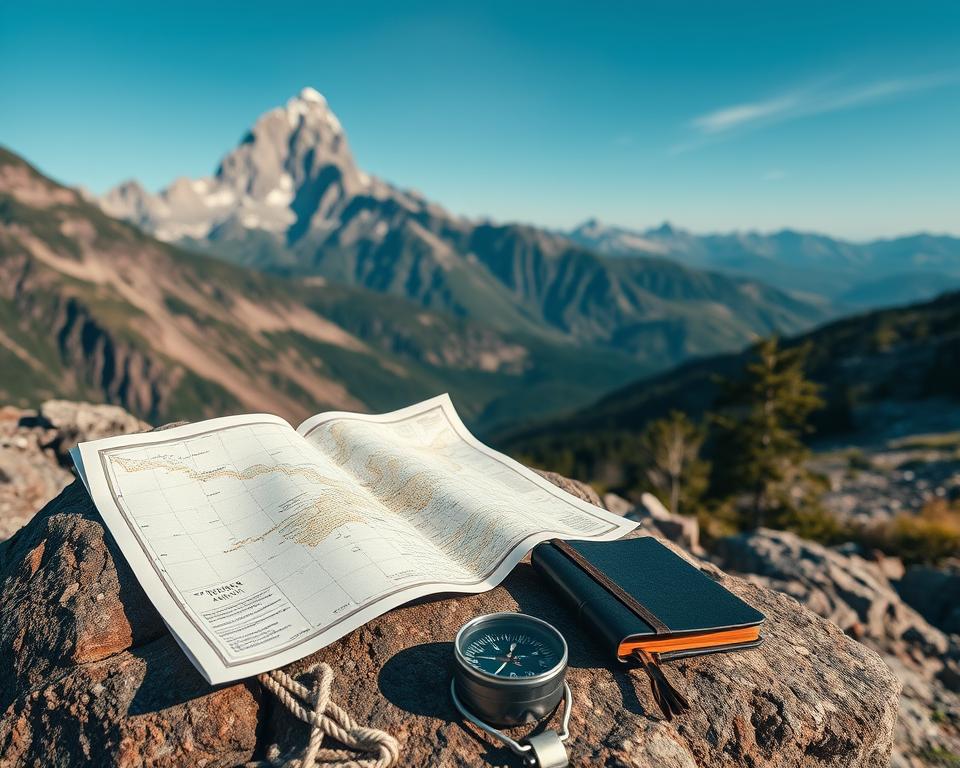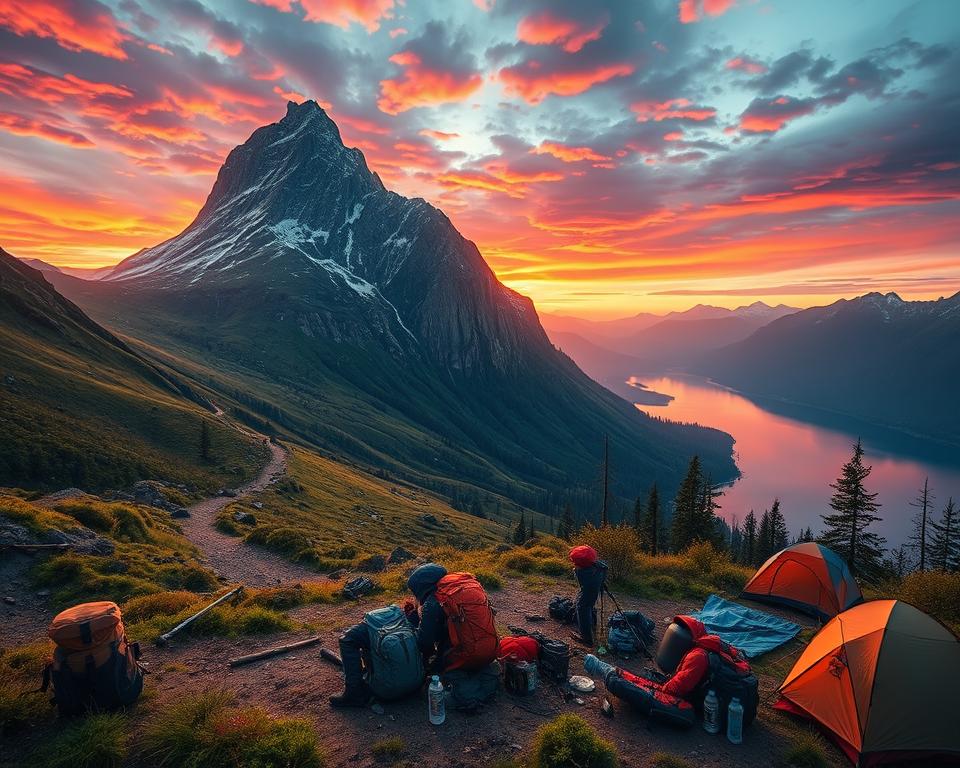Going on a multi-day hike is an exciting adventure. You’ll need to pick the right place and pack the right gear. This guide covers key tips and a full preparation checklist to get you ready for your journey.
First, choose where you want to hike. You should learn about the area, its weather, and what kind of ground you’ll walk on. Did you know 62.5% of places need you to get permits early? And, for 80% of popular spots, you should plan a year ahead. This careful planning ensures you get on the right trail and follow the rules.
To really enjoy your hike, know the rules of your trail. For example, 90% of natural areas limit campfires and 85% have specific spots for camping. Following the 7 Leave No Trace Principles protects these special places.
It’s also smart to check on local animals and the weather ahead of time. Some areas might have bears or wolves, but others don’t. Making a detailed plan, with safety in mind, is crucial. Using Gaia GPS for your route and checking the National Weather Service for forecasts is very helpful.
Whether you’re heading to the Appalachian Mountains or the Tour du Mont Blanc, good planning is key. Follow this guide to plan your backpacking trip well. And, you’ll have a great time exploring!
Choosing Your Destination
Starting a multi-day hiking adventure? The first step is picking a great hiking destination. Whether you love deserts, coasts, or mountains, doing your homework is key.
Researching the Area
Knowing the area well is crucial. Explore popular tracks and local sights thoroughly. Get detailed info to build your adventure’s base.
Look at guidebooks, online forums, or consider guided hikes. Change your plans based on the season to avoid the crowds.
Considering Climate and Terrain
The weather and land affect your hike a lot. When picking trails, think about the weather to stay safe.
For mountain paths, like the Inca Trail, get used to high places. Wear the right clothes and gear, like waterproof jackets.
Evaluating Accessibility and Permits
How easy it is to get to your hiking destination matters. Consider how far it is, your fitness, and how long you’ll hike.
You might camp or hike every day. Some paths need backpacking permits and have rules, especially in famous parks. Match your trip plan with permit needs to dodge problems.
Plan carefully using these tips to make your hike safer and more fun. Happy trails!
How to plan a multi-day hike
Planning your multi-day hike is exciting. You need to pick the right trail, know the rules, and plan your path. Doing this makes sure your adventure goes well. Let’s look at each step of planning a great hike.
Selecting the Perfect Trail
Finding the right trail is key. Think about how far you want to go and your group’s fitness level. Use topo maps, guidebooks, and online resources to find good trails.
- Desired mileage and elevation gain
- Group fitness levels and experience
- Scenic highlights and points of interest
It’s important to choose a trail that’s both fun and challenging. Good research will help you pick a trail everyone likes.
Understanding Local Regulations
Knowing the area’s rules is a must. These rules help keep everyone safe and protect nature. You should look into things like fire rules, bear canister use, and where you can camp. Following these rules helps avoid trouble during your hike.
For example, some places have strict fire rules or require bear canisters. Always check the latest rules with local authorities or park websites before you go.
Mapping Out Your Route
With your trail picked and rules understood, the next step is planning your path. Look into the trail’s details, like where to find water, camp spots, and any hazards. This prep is crucial for a smooth hike.
- Identify water sources and refill points
- Plan daily mileage and set realistic hiking goals
- Mark potential campsites and alternate stops
- Prepare for natural hazards like river crossings and wildlife
Use maps and GPS devices to keep on track. Always have a plan B for unexpected issues like trail closures or bad weather.
By choosing your trail wisely, understanding the rules, and planning your route, you’re ready for a great hiking trip.
Necessary Gear and Supplies
Getting ready for a multi-day hike means planning your gear and supplies well. Let’s dive into what your hiking gear checklist should cover for a safe and fun trip.
Big Three: Backpack, Shelter, Sleep System
First off, let’s talk about the core items you need:
- Backpack: A 65L backpack is perfect for all your gear. It’s important to balance the weight well; try not to carry more than 10% of your weight.
- Shelter: Choose a light tent or a strong shelter for weather changes.
- Sleep System: For good sleep, a 660g down sleeping bag is key.
Navigation Tools: Maps, Compass, GPS
Good navigation tools are a must. You need traditional maps and a compass. Also, a GPS can make things easier and more accurate.
Cooking and Water Purification Systems
For eating and drinking, keep these in mind:
- Cooking: Bring a small camping stove, dishes, and enough snacks and drinks.
- Water Purification: Make sure to have a way to purify water so it’s safe to drink.
Clothing and Footwear
Your clothes and shoes should fit the weather and place. Here’s a quick guide:
- Take two quick-dry shirts, base layers, merino tops, and layers for the sun and cold.
- Pick hiking boots that fit well and are comfy to avoid blisters and have a good hike.
- Bring clip-on ice grips for icy paths.
- Get synthetic puffer jackets and waterproof jackets for different weathers.
- Use a waterproof cover for your backpack and pack clothes in plastic bags for extra safety.
- Stay away from cotton because it smells and doesn’t protect from the sun.
By carefully preparing your hiking checklist and bringing the right gear and tools, your multi-day hike will be a success.
Creating a Backpacking Itinerary
When planning a backpacking trip, making a detailed itinerary is key. Start by deciding on your goals. Do you want a quick weekend trip, a week-long exploration, or a longer adventure? For beginners, 1-2 night hikes covering 5-8 miles per day are perfect.
Next, focus on creating your hike plan. Outline each day’s hiking distance, travel time, and where you might camp. Include breaks, meal times, and when you’ll set up camp. It’s important to keep your plan flexible for unexpected changes, like bad weather.
Also, think about where you’ll find water and places to resupply. Check out resources like the Updated 2023 Gear List and the Backpack Resupply Checklist. Tips from experienced backpackers and renting gear can save money.

A good trail plan means checking trail rules. Many US National Parks ask for wilderness permits. Add fun stops to your plan, like visiting landmarks or relaxing by a lake, to enrich your trip.
Your safety comes first. Tell someone you trust about your plan, including where you’re starting, camping, and when you’ll be back. Consider getting backpacking travel insurance for extra peace of mind.
Before you leave, check your gear works. Stay aware of the weather and the group’s well-being on your hike. Proper preparation means your itinerary will not just guide you but make your adventure better.
Safety and Emergency Plans
Planning a multi-day hike requires a detailed safety and emergency plan. This makes sure you’re ready for any unexpected events. You need to know hiking safety, emergency preparedness, and wilderness first aid.
Emergency Exit Plan
Starting with an emergency exit plan is important. Identify key points on your route for quick evacuation if necessary. Have a way to communicate, like a satellite messenger or locator beacon. A study shows that 37% of hikers practice their evacuation plan before hiking, improving their safety.
It’s crucial to leave your travel details with someone you trust. This helps rescuers know where you are if you need help. The need for fast and efficient emergency exits is shown by the number of hiking accidents requiring evacuation.
First Aid and Wilderness Survival Skills
A full first aid kit is a must-have. Always check and restock it before any trip. Wilderness first aid training is advised. It takes about 16-20 hours and can save lives. This is especially true since accidents can happen to anyone, even skilled hikers.
Knowing other survival skills is also key for emergency situations. Methods like water purification and map reading without GPS are vital. Being cautious on slippery or tricky terrains helps prevent accidents.
Shuttle and Transportation Arrangements
Before your hike, plan your transportation thoroughly. Schedule shuttles to the start point and figure out how to leave once done. This step is essential, especially in remote areas with strict rules. Proper planning avoids legal problems and logistical headaches.
Having detailed transportation plans lowers the chance of accidents and getting lost. With most hikers using smartphones for GPS, checking your transport plans adds safety. It ensures your adventure is secure.
With these hiking safety steps, being emergency-ready, and improving first aid skills, you’re well-prepared for trail emergencies.
How Does Mastering Map and Compass Navigation Enhance My Multi-Day Hiking Adventure Planning?
Mastering map and compass skills is essential for enhancing multi-day hiking adventure planning. With the ability to navigate map compass, hikers can confidently chart their course, identify key landmarks, and adjust routes based on terrain. This knowledge transforms potential challenges into exhilarating experiences, ensuring a safer and more enjoyable journey.
Conclusion
Finishing up your hiking plans is exciting and detailed. You need to pick where you’re going and learn all about it. Getting your gear ready and planning your route are key steps. Don’t forget to think about the weather, the kind of land you’ll be on, and how to get there.
Before you start your hike, it’s good to go over what you’ll bring. Make sure your hiking boots are tough and support your ankles. And that your backpack fits right. Most people who hike a lot can do 10-15 miles a day. But if you’re new, try to go for 3-4 hours instead. Start early to avoid the hot sun, drink lots of water, and clean it if you need to. Packing the right food and extra supplies can help keep you going.
Thinking about my own trips hiking in Nepal and Bhutan, things don’t always go as planned. Being flexible is important. Sometimes, you have to change your plans because of the weather or something else. No matter if you’re new or have hiked a lot, you learn a lot, grow, and feel closer to nature. Enjoy the adventure and every part of the hike. If you want to know more about planning a long hike, I think this guide is great.

